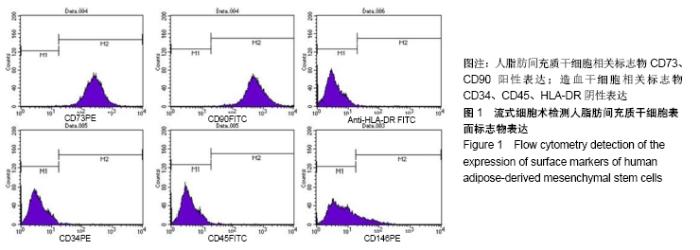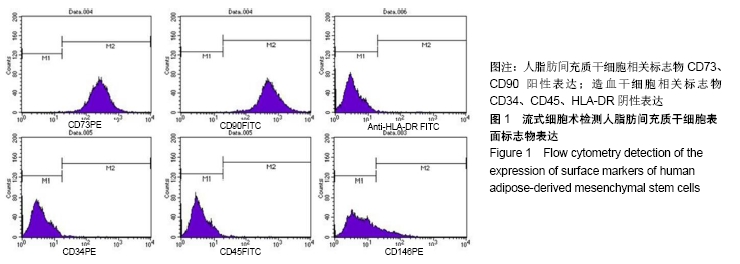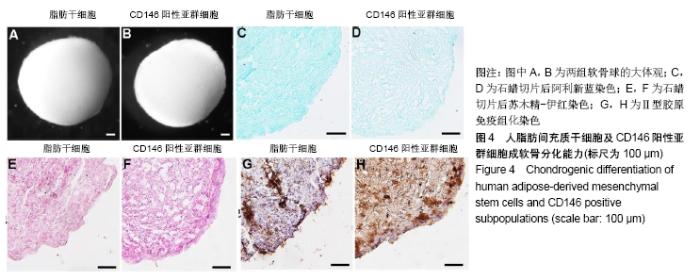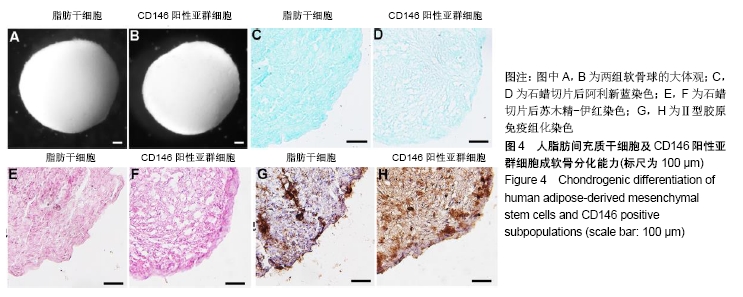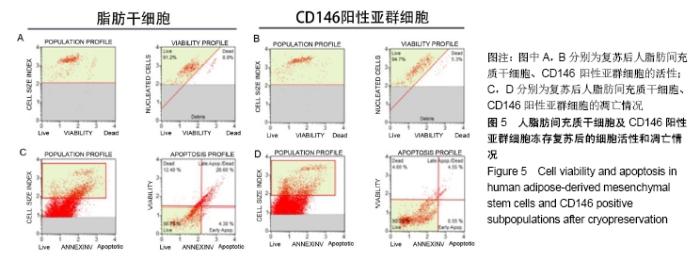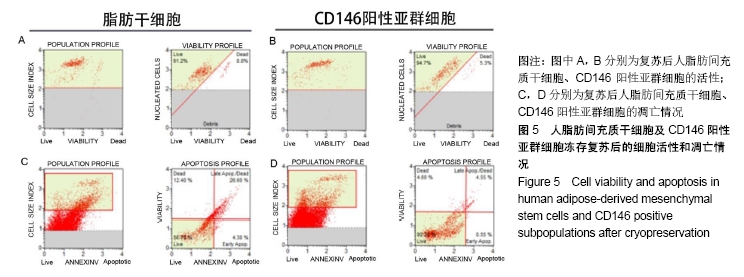Chinese Journal of Tissue Engineering Research ›› 2020, Vol. 24 ›› Issue (19): 2997-3003.doi: 10.3969/j.issn.2095-4344.2033
Previous Articles Next Articles
Application potential of CD146 positive subpopulation as seed cells for cartilage tissue engineering
Sui Xiang1, Tian Guangzhao1, 2, Yang Zhen1, 2, Li Xu1, Liu Shuyun1, Guo Quanyi1
- 1Institute of Orthopedics, General Hospital of Chinese PLA, Beijing Key Laboratory of Regenerative Medicine in Orthopedic, Key Laboratory of Musculoskeletal Trauma & War Injuries of Chinese PLA, Beijing 100853, China; 2School of Medicine, Nankai University, Tianjin 300071, China
-
Received:2019-07-11Revised:2019-07-13Accepted:2019-08-15Online:2020-07-08Published:2020-04-08 -
Contact:Guo Quanyi, Professor, Institute of Orthopedics, General Hospital of Chinese PLA, Beijing Key Laboratory of Regenerative Medicine in Orthopedic, Key Laboratory of Musculoskeletal Trauma & War Injuries of Chinese PLA, Beijing 100853, China -
About author:Sui Xiang, Experimentalist, Institute of Orthopedics, General Hospital of Chinese PLA, Beijing Key Laboratory of Regenerative Medicine in Orthopedic, Key Laboratory of Musculoskeletal Trauma & War Injuries of Chinese PLA, Beijing 100853, China -
Supported by:the National Key Research and Development Plan Program, No. 2018YFC1105900; the National Natural Science Foundation of China, No. 81772319
CLC Number:
Cite this article
Sui Xiang, Tian Guangzhao, Yang Zhen, Li Xu, Liu Shuyun, Guo Quanyi. Application potential of CD146 positive subpopulation as seed cells for cartilage tissue engineering[J]. Chinese Journal of Tissue Engineering Research, 2020, 24(19): 2997-3003.
share this article
| [1] RAI V, DILISIO MF, DIETZ NE, et al. Recent strategies in cartilage repair: A systemic review of the scaffold development and tissue engineering. J Biomed Mater Res A. 2017;105(8):2343-2354. [2] CASO F, COSTA L, DEL PUENTE A, et al. Clinical effects of mud-bath therapy and oral glucosamine sulfate after 6 months of discontinuation in patients with knee osteoarthritis: results from a randomised, controlled, crossover study. Clin Exp Rheumatol. 2017;35(1):169. [3] PELUSO R, CASO F, COSTA L, et al. Mud-bath therapy and oral glucosamine sulfate in patients with knee osteoarthritis: a randomized, controlled, crossover study. Clin Exp Rheumatol. 2016;34(4):618-624. [4] CHAHLA J, PIUZZI NS, MITCHELL JJ, et al. Intra-Articular Cellular Therapy for Osteoarthritis and Focal Cartilage Defects of the Knee: A Systematic Review of the Literature and Study Quality Analysis. J Bone Joint Surg Am. 2016; 98(18):1511-1521. [5] CHOI S, KIM GM, MAENG YH, et al. Autologous Bone Marrow Cell Stimulation and Allogenic Chondrocyte Implantation for the Repair of Full-Thickness Articular Cartilage Defects in a Rabbit Model. Cartilage. 2018;9(4): 402-409. [6] GAO L, GOEBEL LKH, ORTH P, et al. Subchondral drilling for articular cartilage repair: a systematic review of translational research. Dis Model Mech. 2018;11(6): dmm034280. [7] ŻYLIŃSKA B, SILMANOWICZ P, SOBCZYŃSKA-RAK A, et al. Treatment of Articular Cartilage Defects: Focus on Tissue Engineering. In Vivo. 2018;32(6):1289-1300. [8] CONFALONIERI D, SCHWAB A, WALLES H, et al. Advanced Therapy Medicinal Products: A Guide for Bone Marrow-derived MSC Application in Bone and Cartilage Tissue Engineering. Tissue Eng Part B Rev. 2018;24(2): 155-169. [9] VINATIER C, GUICHEUX J. Cartilage tissue engineering: From biomaterials and stem cells to osteoarthritis treatments. Ann Phys Rehabil Med. 2016;59(3):139-144. [10] LOEBEL C, BURDICK JA. Engineering Stem and Stromal Cell Therapies for Musculoskeletal Tissue Repair. Cell Stem Cell. 2018;22(3):325-339. [11] PARK YB, HA CW, RHIM JH, et al. Stem Cell Therapy for Articular Cartilage Repair: Review of the Entity of Cell Populations Used and the Result of the Clinical Application of Each Entity. Am J Sports Med. 2018;46(10):2540-2552. [12] KALAMEGAM G, MEMIC A, BUDD E, et al. A Comprehensive Review of Stem Cells for Cartilage Regeneration in Osteoarthritis. Adv Exp Med Biol. 2018;1089:23-36. [13] JEVOTOVSKY DS, ALFONSO AR, EINHORN TA, et al. Osteoarthritis and stem cell therapy in humans: a systematic review. Osteoarthritis Cartilage. 2018;26(6):711-729. [14] PÉREZ-SILOS V, CAMACHO-MORALES A, FUENTES-MERA L. Mesenchymal Stem Cells Subpopulations: Application for Orthopedic Regenerative Medicine. Stem Cells Int. 2016;2016:3187491. [15] PHINNEY DG. Functional heterogeneity of mesenchymal stem cells: implications for cell therapy. J Cell Biochem. 2012;113(9):2806-2812. [16] CHEN J, LUO Y, HUANG H, et al. CD146 is essential for PDGFRβ-induced pericyte recruitment. Protein Cell. 2018; 9(8):743-747. [17] ESTEVES CL, DONADEU FX. Pericytes and their potential in regenerative medicine across species. Cytometry A. 2018; 93(1):50-59. [18] CRISAN M, CORSELLI M, CHEN WC, et al. Perivascular cells for regenerative medicine. J Cell Mol Med. 2012;16(12): 2851-2860. [19] HÖRL S, EJAZ A, ERNST S, et al. CD146 (MCAM) in human cs-DLK1-/cs-CD34+ adipose stromal/progenitor cells. Stem Cell Res. 2017;22:1-12. [20] SPITZER TL, ROJAS A, ZELENKO Z, et al. Perivascular human endometrial mesenchymal stem cells express pathways relevant to self-renewal, lineage specification, and functional phenotype. Biol Reprod. 2012;86(2):58. [21] CHAN B, SINHA S, CHO D, et al. Critical roles of CD146 in zebrafish vascular development. Dev Dyn. 2005;232(1): 232-244. [22] SACCHETTI B, FUNARI A, MICHIENZI S, et al. Self-renewing osteoprogenitors in bone marrow sinusoids can organize a hematopoietic microenvironment. Cell. 2007; 131(2):324-336. [23] LUO Y, ZHENG C, ZHANG J, et al. Recognition of CD146 as an ERM-binding protein offers novel mechanisms for melanoma cell migration. Oncogene. 2012;31(3):306-321. [24] HAGMANN S, FRANK S, GOTTERBARM T, et al. Fluorescence activated enrichment of CD146+ cells during expansion of human bone-marrow derived mesenchymal stromal cells augments proliferation and GAG/DNA content in chondrogenic media. BMC Musculoskelet Disord. 2014;15: 322. [25] WU CC, LIU FL, SYTWU HK, et al. CD146+ mesenchymal stem cells display greater therapeutic potential than CD146- cells for treating collagen-induced arthritis in mice. Stem Cell Res Ther. 2016;7:23. [26] SU X, ZUO W, WU Z, et al. CD146 as a new marker for an increased chondroprogenitor cell sub-population in the later stages of osteoarthritis. J Orthop Res. 2015;33(1):84-91. [27] LI X, WANG M, JING X, et al. Bone Marrow- and Adipose Tissue-Derived Mesenchymal Stem Cells: Characterization, Differentiation, and Applications in Cartilage Tissue Engineering. Crit Rev Eukaryot Gene Expr. 2018;28(4): 285-310. [28] FRESE L, DIJKMAN PE, HOERSTRUP SP. Adipose Tissue-Derived Stem Cells in Regenerative Medicine. Transfus Med Hemother. 2016;43(4):268-274. [29] FRANCIS SL, DUCHI S, ONOFRILLO C, et al. Adipose-Derived Mesenchymal Stem Cells in the Use of Cartilage Tissue Engineering: The Need for a Rapid Isolation Procedure. Stem Cells Int. 2018;2018:8947548. [30] ZHOU W, LIN J, ZHAO K, et al. Single-Cell Profiles and Clinically Useful Properties of Human Mesenchymal Stem Cells of Adipose and Bone Marrow Origin. Am J Sports Med. 2019;47(7):1722-1733. [31] MAGNE D, VINATIER C, JULIEN M, et al. Mesenchymal stem cell therapy to rebuild cartilage. Trends Mol Med. 2005; 11(11): 519-526. [32] 魏一凡,曾静,张巍,等.软骨组织工程中脂肪干细胞:标记物、基因修饰及与支架的理想结合[J].中国组织工程研究, 2018,22(21): 3424-3430. [33] MA Q, LIAO J, CAI X. Different Sources of Stem Cells and their Application in Cartilage Tissue Engineering. Curr Stem Cell Res Ther. 2018;13(7):568-575. [34] FELLOWS CR, MATTA C, ZAKANY R, et al. Adipose, Bone Marrow and Synovial Joint-Derived Mesenchymal Stem Cells for Cartilage Repair. Front Genet. 2016;7:213. [35] WU L, CAI X, ZHANG S, et al. Regeneration of articular cartilage by adipose tissue derived mesenchymal stem cells: perspectives from stem cell biology and molecular medicine. J Cell Physiol. 2013;228(5):938-944. [36] ZHANG J, DU C, GUO W, et al. Adipose Tissue-Derived Pericytes for Cartilage Tissue Engineering. Curr Stem Cell Res Ther. 2017;12(6):513-521. [37] ESTEVES CL, SHELDRAKE TA, MESQUITA SP, et al. Isolation and characterization of equine native MSC populations. Stem Cell Res Ther. 2017;8(1):80. [38] PLOUFFE BD, MURTHY SK, LEWIS LH. Fundamentals and application of magnetic particles in cell isolation and enrichment: a review. Rep Prog Phys. 2015;78(1):016601. [39] TAN AR, HUNG CT. Concise Review: Mesenchymal Stem Cells for Functional Cartilage Tissue Engineering: Taking Cues from Chondrocyte-Based Constructs. Stem Cells Transl Med. 2017;6(4):1295-1303. [40] 于瑶,殷宗琦,李丹,等.人耳软骨细胞冻存复苏后的体外成软骨能力及体内转归的研究[J].组织工程与重建外科杂志, 2019,15(3): 137-141. [41] 薛鹏举,敖俊,赵利涛,等.人髓核细胞体外培养及冻存的实验研究[J].中国现代医学杂志,2016,26(23):53-58. |
| [1] | Li Jiacheng, Liang Xuezhen, Liu Jinbao, Xu Bo, Li Gang. Differential mRNA expression profile and competitive endogenous RNA regulatory network in osteoarthritis [J]. Chinese Journal of Tissue Engineering Research, 2021, 25(8): 1212-1217. |
| [2] | Geng Qiudong, Ge Haiya, Wang Heming, Li Nan. Role and mechanism of Guilu Erxianjiao in treatment of osteoarthritis based on network pharmacology [J]. Chinese Journal of Tissue Engineering Research, 2021, 25(8): 1229-1236. |
| [3] | Fan Quanbao, Luo Huina, Wang Bingyun, Chen Shengfeng, Cui Lianxu, Jiang Wenkang, Zhao Mingming, Wang Jingjing, Luo Dongzhang, Chen Zhisheng, Bai Yinshan, Liu Canying, Zhang Hui. Biological characteristics of canine adipose-derived mesenchymal stem cells cultured in hypoxia [J]. Chinese Journal of Tissue Engineering Research, 2021, 25(7): 1002-1007. |
| [4] | Li Yonghua, Feng Qiang, Tan Renting, Huang Shifu, Qiu Jinlong, Yin Heng. Molecular mechanism of Eucommia ulmoides active ingredients treating synovitis of knee osteoarthritis: an analysis based on network pharmacology [J]. Chinese Journal of Tissue Engineering Research, 2021, 25(5): 765-771. |
| [5] | Song Shan, Hu Fangyuan, Qiao Jun, Wang Jia, Zhang Shengxiao, Li Xiaofeng. An insight into biomarkers of osteoarthritis synovium based on bioinformatics [J]. Chinese Journal of Tissue Engineering Research, 2021, 25(5): 785-790. |
| [6] | Deng Zhenhan, Huang Yong, Xiao Lulu, Chen Yulin, Zhu Weimin, Lu Wei, Wang Daping. Role and application of bone morphogenetic proteins in articular cartilage regeneration [J]. Chinese Journal of Tissue Engineering Research, 2021, 25(5): 798-806. |
| [7] | Chen Yang, Huang Denggao, Gao Yuanhui, Wang Shunlan, Cao Hui, Zheng Linlin, He Haowei, Luo Siqin, Xiao Jingchuan, Zhang Yingai, Zhang Shufang. Low-intensity pulsed ultrasound promotes the proliferation and adhesion of human adipose-derived mesenchymal stem cells [J]. Chinese Journal of Tissue Engineering Research, 2021, 25(25): 3949-3955. |
| [8] | Chen Feng, Zhang Xiaoyun, Chen Yueping, Liao Jianzhao, Li Jiajun, Song Shilei, Lai Yu. Molecular mechanism of anhydroicaritin in the treatment of osteoarthritis: an analysis based on network pharmacology and bioinformatics [J]. Chinese Journal of Tissue Engineering Research, 2021, 25(23): 3704-3710. |
| [9] | Zhang Jianhui, Ma Heran, Tan Yi, Wang Zhihui. Knee injury repair using human adipose-derived mesenchymal stem cells-based scaffold-free three-dimensional gel-like construct in pigs [J]. Chinese Journal of Tissue Engineering Research, 2021, 25(19): 2969-2975. |
| [10] | Li Congcong, Yao Nan, Huang Dane, Song Min, Peng Sha, Li Anan, Lu Chao, Liu Wengang. Identification and chondrogenic differentiation of human infrapatellar fat pad derived stem cells [J]. Chinese Journal of Tissue Engineering Research, 2021, 25(19): 2976-2981. |
| [11] | Yang Tengyun, Li Yanlin, Liu Dejian, Wang Guoliang. Application prospects and problems of peripheral blood derived mesenchymal stem cells in cartilage repair of osteoarthritis [J]. Chinese Journal of Tissue Engineering Research, 2021, 25(19): 3071-3076. |
| [12] | Yuan Changshen, Rong Weiming, Lu Zhixian, Duan Kan, Guo Jinrong, Mei Qijie. Construction of osteosarcoma miRNA-mRNA regulatory network based on bioinformatics [J]. Chinese Journal of Tissue Engineering Research, 2021, 25(17): 2740-2746. |
| [13] | Shen Fu, Kuang Gaoyan, Yang Zhuo, Wen Meng, Zhu Kaimin, Yu Guizhi, Xu Wuji, Deng Bo . Immune infiltration mechanism of differential expression genes in rheumatoid arthritis and potential therapeutic prediction of Chinese herbs [J]. Chinese Journal of Tissue Engineering Research, 2021, 25(14): 2183-2191. |
| [14] | Liu Peidong, Feng Jiangfeng, Xu Wenjie, Xu Xiaodong, Yang Ziquan . Bioinformatics analysis of gene expression profile and key pathways related to fatty infiltration after rotator cuff injury [J]. Chinese Journal of Tissue Engineering Research, 2021, 25(11): 1773-1778. |
| [15] | Li Shengqiang, Xie Bingying, Chen Juan, Xie Lihua, Huang Jingwen, Ge Jirong. Interaction proteomics of long noncoding RNA uc431+ gene in postmenopausal osteoporosis [J]. Chinese Journal of Tissue Engineering Research, 2021, 25(11): 1641-1646. |
| Viewed | ||||||
|
Full text |
|
|||||
|
Abstract |
|
|||||
